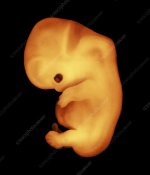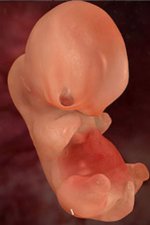From your own source:
article said:
Specialised nerve terminals, nociceptors, are likely to detect surgical tissue damage from early in fetal life (around 10 weeks for the skin and 13 weeks for the internal organs). These nociceptors gradually mature over the next 6–8 weeks and the strength of their signals increases over fetal life. The presence of nociceptors is necessary for perception of acute surgical pain and so pain is clearly not possible before the nociceptors first appear at 10 weeks.
Note that this doesn't say pain at 10 weeks, it says there can't be pain before 10 weeks.
Here's what it says....
"Anatomical studies of human fetal skin shows the presence of nerve terminals and fibres deep in the skin from 6 weeks of gestational age."
Able to be detected as early as 6 weeks. Nerves.
"These terminals are not [mature] nociceptors..."
Sure. But so what?
Call them whatever you like. They are sensory nerves endings.
[nociceptors]"...are specialised for the processing of non-damaging sensations such as touch, vibration and temperature, rather than pain."
Note that these are described as being "
specialised" for sensations.
...at 6 weeks.
...a living human.
Note that "specialised for" does NOT mean "used
exclusively for".
And that "non-damaging sensations" does NOT mean "not painful".
The
touch, vibration and temperature experienced - sensed - by these specialised nerve endings can be either painful or pleasant or neutral, and it can still be claimed that no "damage" is done. This is equally true for children who have already been born. Would anyone (other than a pedophile) argue that "non-damaging" touching is equivalent to neutral, painless sensory experience?
"Non-damaging" high temperatures can be pleasurable in some circumstances and painful/unpleasant in other circumstances. The same goes for "non-damaging" low temperatures.
This study shows that, as early as 6 weeks, the fetus has specialised nerve endings which can experience "non-damaging" sensations. That these sensory nerve endings are already starting to become "specialised" to some degree does not mean
that...therefore the temperature experienced isn't painful, the touch being experienced isn't painful, the vibration being experienced isn't painful.
The precise point at which non-damaging
temperature, touch, vibration becomes unpleasant is a matter of degree. The fact that the study specifies "non-damaging" should tell you something.
"From 10 weeks, nerve terminals become more numerous and extend towards the outer surface of the skin."
This is simply another way of saying nerve terminals continue becoming even more numerous after 6 weeks. Not less. We don't have the scientific tools needed to detect and precisely measure what happens earlier than six weeks, but we certainly know that from
at least six weeks onwards this sensory ability increases. 6 weeks, 7 weeks, 8 weeks, 9 weeks. It's not like everything remains static until you get to some magical 10 week milestone.
Functional, sensory nerve terminals are extant from at least as early as 6 weeks.
."The terminals closer to the surface are likely to be immature nociceptors, necessary for pain experience following tissue damage..."
Read that carefully. Those nerve terminals detected as early as six weeks and becoming more numerous over the 6, 7, 8, 9 to 10 week timeframe are
likely to be nociceptors - immature or otherwise.
Note the term pain experience. The way we verify pain sensation is by looking for fetal response to some given stimuli. And note that my claim was that the fetus responds to external stimuli- painful or otherwise, non-damaging or otherwise - from as early as six weeks.
"but they [mature nociceptors] are not unequivocally present until 17 weeks."
Sure. So what?
This simply means that the case for fetal pain sensory capacity gets more and more undeniable as time goes by...6, 7, 8, 9, 10 weeks...11, 12, 13 14 weeks...
Unequivocally true. No semantics or disambiguation about
non-damaging touch,
unpleasant temperatures,
annoying vibration. No quibbling about whether an '
immature' nociceptor really is a nociceptor. From six weeks onwards, the case for fetal respose to external stimuli - painful or pleasant - becomes increasingly UNAMBIGUOUS.
"...In other mammals, newly formed fetal nociceptors are able to signal tissue damage but the intensity of their signals is weaker than in adults"
More verification that fetal pain signals are experienced - however weak or otherwise.
...science has provided evidence - empirical, repeatable, evidence - that unborn babies respond to external stimuli as early as 6 weeks from conception. The myth that embryos feel no pain has been falsified by science.



